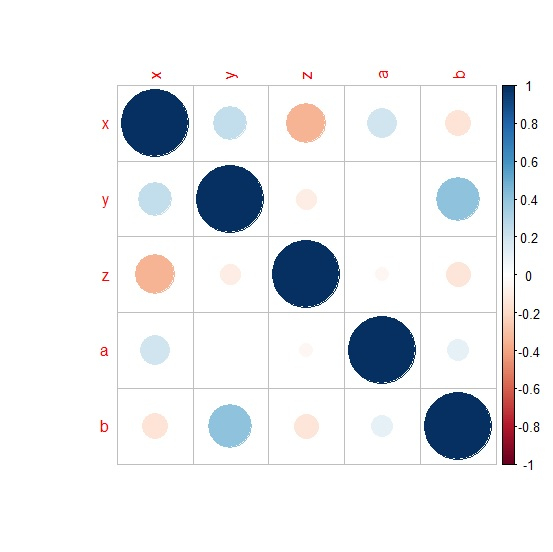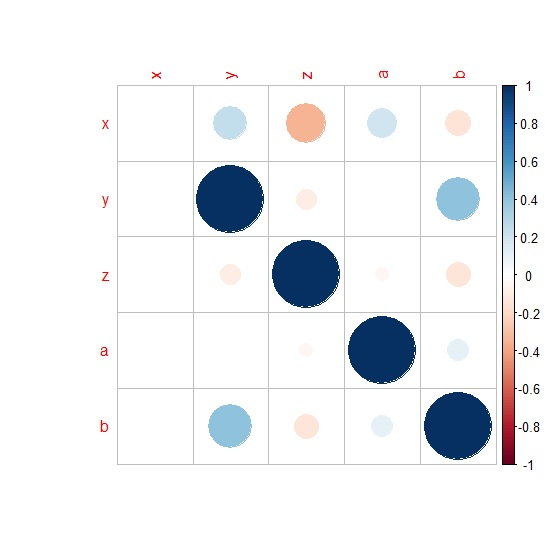
 Data Structure
Data Structure Networking
Networking RDBMS
RDBMS Operating System
Operating System Java
Java MS Excel
MS Excel iOS
iOS HTML
HTML CSS
CSS Android
Android Python
Python C Programming
C Programming C++
C++ C#
C# MongoDB
MongoDB MySQL
MySQL Javascript
Javascript PHP
PHP
- Selected Reading
- UPSC IAS Exams Notes
- Developer's Best Practices
- Questions and Answers
- Effective Resume Writing
- HR Interview Questions
- Computer Glossary
- Who is Who
How to disable the display of some correlations using corrplot in R?
When we create a correlation plot using corrplot the correlation among variables is displayed on the plot, if we want to disable some of those correlations then we first need to set them to NA in the correlation matrix and then use the corrplot function with na.label set to blank as " ".
Check out the below given example to understand how it works.
Example
Following snippet creates a sample data frame −
x<-rpois(20,5) y<-rpois(20,1) z<-rpois(20,2) a<-rpois(20,5) b<-rpois(20,2) df<-data.frame(x,y,z,a,b) df
Output
The following dataframe is created −
x y z a b 1 7 1 3 8 2 2 6 0 2 9 1 3 7 3 0 4 4 4 3 1 3 5 4 5 3 1 0 6 5 6 4 0 4 3 0 7 3 3 5 3 3 8 8 1 0 1 1 9 8 1 2 7 0 10 6 4 3 5 4 11 4 0 5 5 4 12 1 0 5 4 1 13 6 2 0 7 2 14 5 2 5 5 0 15 3 0 1 3 1 16 5 0 1 2 1 17 4 1 2 5 2 18 3 1 2 6 1 19 6 0 5 5 2 20 5 1 1 7 3
To create correlation matrix for data in df, add the following code to the above snippet −
x<-rpois(20,5) y<-rpois(20,1) z<-rpois(20,2) a<-rpois(20,5) b<-rpois(20,2) df<-data.frame(x,y,z,a,b) Corr_M<-cor(df) Corr_M
Output
If you execute all the above given snippets as a single program, it generates the following output −
x y z a b x 1.0000000 0.24491966 -0.34910183 0.19145954 -0.1414168 y 0.2449197 1.00000000 -0.09383816 0.00000000 0.4081691 z -0.3491018 -0.09383816 1.00000000 -0.04151439 -0.1358051 a 0.1914595 0.00000000 -0.04151439 1.00000000 0.1013302 b -0.1414168 0.40816908 -0.13580512 0.10133025 1.0000000
To load corrplot package and create corrplot of correlation matrix Corr_M, add the following code to the above snippet −
library(corrplot) corrplot(Corr_M)
Output
If you execute all the above given snippets as a single program, it generates the following output −

To set the first column of Corr_M to NA, add the following code to the above snippet −
Corr_M[,1]<-NA Corr_M
Output
If you execute all the above given snippets as a single program, it generates the following output −
x y z a b x NA 0.24491966 -0.34910183 0.19145954 -0.1414168 y NA 1.00000000 -0.09383816 0.00000000 0.4081691 z NA -0.09383816 1.00000000 -0.04151439 -0.1358051 a NA 0.00000000 -0.04151439 1.00000000 0.1013302 b NA 0.40816908 -0.13580512 0.10133025 1.0000000
To create corrplot of Corr_M again to visualize the correlation plot without first column, add the following code to the above snippet −
corrplot(Corr_M,na.label=" ")
Output
If you execute all the above given snippets as a single program, it generates the following output −


